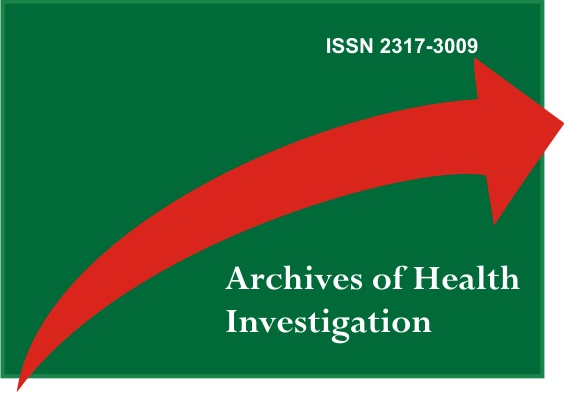Comparison of Diagnosed Cases with the Degree of Knowledge of Dentistry students at the University Center of Adamantina about Oral Cancer
DOI:
https://doi.org/10.21270/archi.v11i3.5710Keywords:
Oral Cancer, Dental Students, Oral Neoplasms, Attitudes and Health PracticeAbstract
Oral cancer remains, despite advances, a public health problem worldwide. For the prognosis to be favorable, the lesion must be identified at an early stage, taking into account its clinical characteristics. This study aimed to analyze clinical cases of patients affected by Squamous Cell Carcinoma and compare the level of knowledge of undergraduate dentistry students facing a diagnosis of oral cancer. The clinical history of the medical records of patients with this diagnosis was investigated, respecting their identity, and a questionnaire was carried out with students to compare the level of knowledge with the inherent characteristics of our region in relation to oral cancer. The results obtained are in accordance with the articles studied, taking into account that Cancer generally affects men between 40 and 80 years old, who have the habit of drinking and smoking. The most affected area was the tongue, with ulcerated and irregular lesions in smokers. The knowledge of dentistry students was satisfactory, according to the clinical characteristics found in the cases studied. It is concluded that diagnosing oral cancer at an early stage is the most effective way to reduce morbidity, difficulty and treatment extension. Thus, the study aimed to report how important the Dental Surgeon is in the clinical knowledge of the lesion, as this may be the first professional to come across this disease. Public health actions are also essential to alert the population about the risk factors that lead to the onset of the disease.
Downloads
References
Ferlay J, Soerjomataram I, Dikshit R, Eser S, Mathers C, Rebelo M, Parkin DM, Forman D, Bray F. Cancer incidence and mortality worldwide: sources, methods and major patterns in GLOBOCAN 2012. Int J Cancer. 2015;136(5):E359-86
De Carvalho Freitas Ramos T, Araújo Almeida L, Daltro Borges Alves L, Souza Freitas V, Mendes Daltro Borges T, Dourado Martins J. Perfil clínico-demográfico de los carcinomas de células escamosas bucales en una población del nordeste de Brasil. Rev Asoc Odontol Argent 2019;107:5-9.
Volkweis MR, Blois MC, Zanin R, Zambonzi R. Perfil Epidemiológico dos Pacientes com Câncer Bucal em um CEO. Rev. cir. traumatol. buco-maxilo-fac.2014;14(2):63-70.
Oncoguia. Estatística para câncer de boca e orofaringe. Disponível em: http://www.oncoguia.org.br/conteudo/estatistica-para-cancer-de-boca-e-orofaringe/7427/278/. (20 de Setembro de 2021). Acesso em 20 de Outubro de 2021.
Instituto Nacional do Câncer (INCA). Dados e números da prevalência do tabagismo. Disponível em:https://www.inca.gov.br/observatorio-da-politica-nacional-de-controle-do-tabaco/dados-e-numeros-prevalencia-tabagismo. Acesso em 17 de Novembro de 2021
Instituto Nacional do Câncer (INCA). Incidência de câncer no Brasil.(2010). Disponível em: http://www.inca.gov.br/estimativa/2010/estimativa20091201.pdf. Acesso em 17 de Novembro de 2021.
Simonato, LE, Miyahara GI. O Papel do Papilomavírus Humano na Carcinogênese Bucal. Rev Bras Cancerol. 2007;53(4):471-6.
Cremonesi AL, Quispe RA, Garcia AS, SantosP SS. Queilite actínica: um estudo retrospectivo das características clinicas e histopatológicas. Arq Med Hosp Fac Cienc Med Santa Casa São Paulo. 2017;62(1):7-11.
Cintra, JS. Queilite Actínica: Estudo epidemiológico entre trabalhadores rurais do município de Piracaia - SP. Rev Assoc Paul Cir Dent. 2013;1(6):105-10.
Tenorio EP, Santos JAP, Ferreira SMS, Peixoto FB, Ribeiro CMB. Queilite actínica: relato de caso. Rev Med Minas Gerais.2018;28(e-1970):1-6.
Santos LCO, Batista OM, Cangussu MCT. Caracterização do diagnóstico tardio do câncer de boca no estado de Alagoas. Braz J Otorhinolaryngol.2010;76(4):416-422.
Humphris GM, Freeman R, Clarke HMM. Risk Perception of Oral Cancer in Smokers Attending Primary Care: a Randomized Controlled Trial. Oral Oncol. 2004;40:916-24.
Ministério da Saúde. Secretaria de Assistência à Saúde. Instituto Nacional de Câncer.- INCA, Falando Sobre Câncer da Boca. – Rio de Janeiro: INCA, 2002.
Scott SE, Grunfeld EA, Mcgurk M. The idiosyncratic relationship between diagnostic delay and stage of oral squamous cell carcinoma. Oral Oncol. 2005;41(4):396-403.
Kowalski LP, Carvalho AL, Martins Priante AV, Magrin J. Predictive factors for distant metastasis from oral and oropharyngeal squamous cell carcinoma. Oral Oncol. 2005;41(5):534-41.
Galbiatti AL, Padovani-Junior JA, Maníglia JV, Rodrigues CD, Pavarino ÉC, Goloni-Bertollo EM. Head and neck cancer: causes, prevention and treatment. Braz J Otorhinolaryngol. 2013;79(2):239-47.
Cicco R. Conheça os 4 estágios do câncer de boca. Cirurgia e Oncologia de Cabeça e Pescoço. Dr Rafael de Cicco. Disponível em: https://rafaeladecicco.com.br/estagios-do-cancer-de-boca/. Acesso em 16 de Julho de 2021.
Neville BW, Damm DD. Patologia Oral e Maxilofacial, 4.ed. Elsevier Editora Ltda, 2016.


